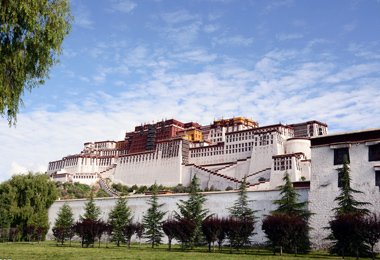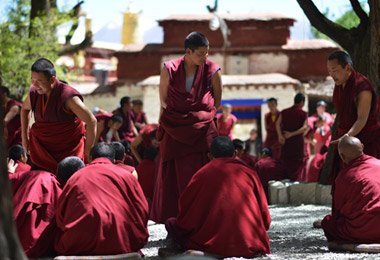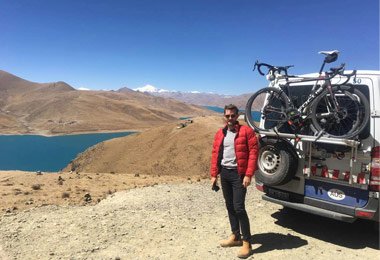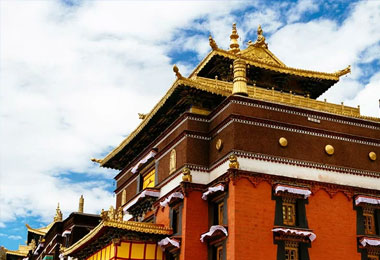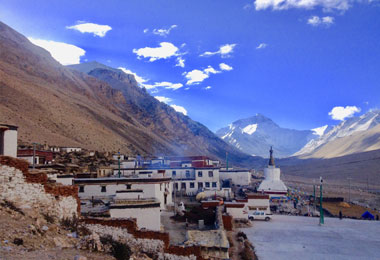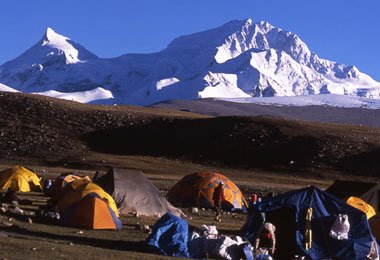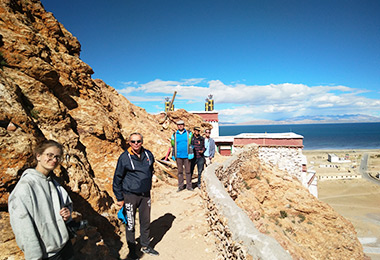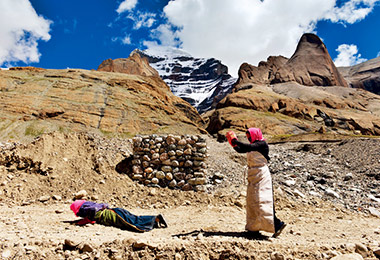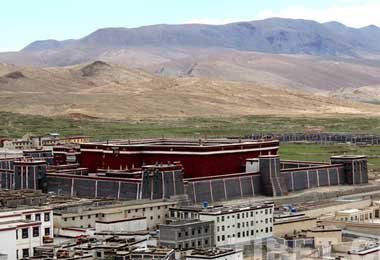
14 Days Ultimate Holy Mt.Kailash and Manasarovar Meditation Tour
(TMT04) Lhasa-Gyantse-Shigatse-Everest Base Camp-Saga-Darchen-Drirapuk-Darchen-Saga-Sakya-Shigatse-Lhasa
-
Tour Type:
Escorted by private guide and vehicle; leave 365 days a year!
-
Trip Level:
Easy - suitable for all levels of fitness, family with kids and senior groups.
-
Trip Level Guide:
- Easy - suitable for all level of fitness, family with kids and senior groups.
- Moderate - suitable for ones with average level fitness, family with kids bigger than 12 yrs.
- Moderate to Strenous - suitable for ones physically fit; have experiences of high altitude trek.
- Strenuous: suitable for adventures and individual with physically fit and healthy.
-
Season:春
Spring夏
Summer秋
Autumn冬
Winter
Overview
One of the most outstanding tours on the Tibetan plateau, this spectacular 14-day trip takes you to the most sacred pilgrimage site on the planet, the stunning and sacred Mount Kailash, held in divine reverence in four religions. An awesome chance to meditate at some of the most sacred and holy sites in Tibet, including the Drirapuk Monastery on the Mount Kailash Kora, the famous Tashilhunpo Monastery, and the renowned Rongbuk Monastery, this trip is the ultimate in meditation tours in Tibet. What’s more, you will also get to visit some of the remarkable sites across Tibet, and take a short trek along the western side of Mount Kailash.
At a Glance
Day 1Arrival in Lhasa (3,650m)
Day 2Lhasa Tour - Potala Palace, Jokhang Temple, and Barkhor Street
Day 3Lhasa Tour: Pabonka, Pabonka, Rizhui, and Sera Monastery
Day 4Travel from Lhasa to Shigatse via Gyantse (360km)
Day 5Travel from Shigatse to EBC (350km)
Day 6Journey from EBC to Saga (450km)
Day 7Saga to Darchen via Lake Manasarovar (450km)
Day 8Enjoy the trek from Darchen to Drirapuk (driving 7km, trek 13km)
Day 9Half day mediation around Drirapuk Monastery and trek back to Darchen
Day 10Meditation beside Lake Manasarovar and Drive back to Saga
Day 11Saga to Sakya (350km)
Day 12Sakya to Shigatse (170km)
Day 13Shigatse to Lhasa (274 km)
Day 14Depart from Lhasa
Day to Day Itinerary
Day 1: Arrival in Lhasa (3,650m)
Highlights:
Receive the auspicious White Hada and Tibet Travel guide from our Tibetan guide;
Get a glimpse of Potala Palace and holy Lhasa city;
Tashi Delek! Welcome to Lhasa, the modern utopia as well as the spiritual heart of Tibet; Your hospitable Tibetan guide and friendly drivers have already been expecting you at the designated places at the Lhasa Gonggar Airport or Lhasa Railway Station.
As you receive our auspicious white Hada, simply leave your hassle to our staff to take care and enjoy the scenic ride to your hotel in Lhasa city. Our handful Tibetan guide will help you check in and inform you of the travel plan the next day. Then have a good rest at the hotel for tomorrow’s exciting tour.
Meal: No Meal is included today
Accommodation: Lhasa Yak Hotel (3 star), Cang-Gyan Lhasa Hotel (4 star), upgrade available when needed.
Insider Tips:
For the new-comers to Tibet, never rush to visit attractions downtown as your body needs time to get acclimatized to the high altitude on Tibetan Plateau. Slight headache, dizziness, and rapid pulse are pretty common. They will disappear in a couple of days. Feel anything you need, please feel free to reach your Tibetan guide. Pay special attention to sun protection when meditating in the wilderness in Tibet.
Day 2: Lhasa Tour - Potala Palace, Jokhang Temple, and Barkhor Street
Highlights:
Explore the White House and Red House in Potala Palace;
Enjoy the bird’s eye view of Lhasa city from Potala;
Visit the sandalwood statue of Sakyamuni in Potala; the life-size statue of Sakyamuni in Jokhang;
Experience the famous Barkhor Kora;
Taste Tibetan sweet tea and other local food.
Basking in eye-blinding sunshine, Lhasa is teeming with magnificent Buddhist temples and monasteries, devoted Tibetan pilgrims and historical backstreets, pleasing culinary discovery.
Follow the footsteps of your guide to hike the long stairs of impressive Potala Palace for the commanding view of Lhasa city; the UNESCO heritage site perched on the Red hill used to be the winter palace of the generations of Dalai Lama. Now, it is the most iconic building of Tibet. You will have a chance to explore the residence of Dalai Lama in White Palace and religious chambers in the Red Palace and gilded burial stupas of former Dalai Lamas, etc.
After lunch, we will head to Jokhang Temple, the holiest Buddhist site in Lhasa. Traveling in the dimly-lit rooms, you can hear the constant mumbling of Buddhist chanting and see local Tibetans adding butter oil to the oil lamps. Never miss the chance to worship the life-size statue of 12-year-old Buddha Sakyamuni.
Outside the Jokhang Temple, follow the prostrating Tibetan pilgrims for the famous Barkhor kora nearby. You may also look for the delicately-made souvenirs in the boutiques that flank the Barkhor Street.
When you head starts to spin, delve into the quiet backstreet of Barkhor and treat yourself with a couple of tasty sweet tea and local delicacy and fully immerse yourself in the distinct vibes of a local teahouse.
At the light falls, the lively music bars and restaurants take on a different splendor for you to explore.
Meal: Breakfast
Accommodation: Lhasa Yak Hotel (3 star), Cang-gyan Lhasa Hotel (4 star), upgrade available when needed.
Insider Tips:
As each traveler only has one hour for visiting Potala Palace, do closely follow our guide’s guidance;
walk slowly and take a rest if needed when you hike the Potala Palace;
Dress properly when visiting the Buddhist site and no photo is allowed inside the Buddhist hall.
With time permitting, you may also visit Tibetan handicraft art or Tibetan Traditional Medicine center and farm produce market in Tromsikhang Market. You can upgrade your service to enjoy Tibetan Culture Show in the evening (fr. 60USD)
Day 3: Lhasa Tour: Pabonka, Pabonka, Rizhui, and Sera Monastery
Highlights:
Visit Pabonka Palace
Meditate in Pabongka Rizhui
Enjoy the Birds’ eye view of Lhasa city
Experience the lively monk debate and colorful sand mandala in Sera Monastery
Have an early rise for the breakfast at hotel; later we will enjoy the ride to the cliff-side Pabonka, a Tibetan palace 15km from the Lhasa; briefly visit the holy cave where Songtsen Gampo the 33rd Tibetan king used to meditate.
Keep following the scenic hike that takes around 30 minutes behind Pabonka; we will reach Pabongka Rizhui, an exceedingly peaceful and remote Buddhist temple that has a commanding view of the Lhasa city. You may enjoy the perfect solitude and meditate here for hours.
Then we will travel back to Lhasa for the lunch at around noon. After lunch, make it to the prominent Sera Monastery; the second biggest Gelugpa monastery in Lhasa now is the major stage for the “monk debate”. Find a spot in the boisterous debate courtyard to enjoy this dramatic “monastic defense”. Though you may not understand what they say, the slapping of hands, yelling and jumping and rolling of Buddhist mala give you a vivid display of long-held tradition of Buddhist study. Besides, you may also enjoy exquisite sand mandala and Buddhist scripture printing press and visit the main assembly hall in this Buddhist academy.
Meal: Breakfast
Accommodation: Lhasa Yak Hotel (3 star), Cang-gyan Lhasa Hotel (4 star), upgrade available when needed.
Insider Tips:
In fact, if you prefer, you may spend days mediating in Pabongka Rizhui. However, sleeping in the Buddhist compound is not allowed according to the Tibet travel policy for international tourists. However, we can arrange the transfer service for you from Lhasa or you may stay with our Tibetan guide in the local guesthouse nearby. And “Rizhi” literally means a place for meditation in Tibetan.
Day 4: Travel from Lhasa to Shigatse via Gyantse (360km)
Highlights:
View and stop at Lake Yamdrok
Photos with Tibetan mastiffs
Visit Karola Glacier
Hang Prayer Flags at Simila Pass
Visit Pelkor Monastery and climb the Gyantse Kumbum
After a good breakfast, we will depart from Lhasa to head to Shigatse, the stop for today. The route takes us over the stunning Gampala Pass (4,790m), where you will get your first glimpse of Lake Yamdrok. The view of the lake from the pass is astounding, and you can see for many miles, with great views of the snow-capped mountains that fringe the lake, including the highest mountain near Lhasa, Mount Nyenchen Khangsar, at 7,191 meters.
After a short drive, we will arrive at the lake’s northern shores, where you can spend a few hours strolling around the lake before tucking in to a delicious picnic. The peaceful and serene shores of this sacred lake are an ideal spot for relaxing and getting back in touch with nature. One of the highlights of Lake Yamdrok is the opportunity to have your photo taken with a huge Tibetan mastiff, one of the rarest dogs on the planet and a renowned guard dog for the Tibetan nomadic herders.
In the afternoon, we will continue our journey to Shigatse, stopping at the famous Karola Glacier, one of the many pristine glaciers in Tibet. On the way to the glacier, we will pass over Simila Pass (4,200m), where we can stop for you to hang prayer flags, in the tradition of most devout Tibetan pilgrims.
After we arrive in Gyantse, we will head straight for the Pelkor Chode Monastery, the location of the famous Gyantse Kumbum, a 32-meter stupa that is the only one of its kind in Tibet. You can climb up to the upper levels of this 9-storey stupa, and after we will take a walk around the rest of the monastery.
After another 90 minutes of driving from Gyantse, we will arrive in the second city of Tibet, Shigatse, where we will stop for the night.
Meal: Breakfast
Accommodation: Manasaroval Hotel (3-star), Tashi Choeta Hotel(4-star), Shigatse Gesar Hotel(4-star), upgrade available when needed.
Insider Tips:
Gyantse lies at an elevation of 4,500 meters, so it is best not to hurry when wandering around the monastery and the old streets because of the increased altitude from Lhasa. Lake Yamdrok has very little shade around it, so you need to take care when meditating in the open air, and cover up to protect yourself from the harsh sunlight.
Day 5: Travel from Shigatse to EBC (350km)
Highlights:
Visit Tashilhunpo Monastery
Meditate with the monks in the Assembly Hall
Cross the scenic passes to EBC
Enjoy the vista of the Himalayas
Explore Everest Base Camp
Experience staying in a traditional yak-hair tent
In the morning, we will visit the famous Tashilhunpo Monastery. Built in 1447 by the first Dalai Lama, the monastery is the traditional seat of the Panchen Lama, the second highest Buddhist incarnation in Tibet.
After touring around the monastery, we will enter the assembly hall, where the monks of the monastery practice their ritual chanting. Here we will be able to meditate for an hour or two, relaxing to the sounds of the ritual chanting, a mesmerizing sound in the silence of the monastery.
Before lunch, we will depart from Shigatse for Mount Everest Base Camp and the famous Rongbuk Monastery. The route to the base camp runs over three high passes, the first two being the Tsola Pass (4,600m) and the Gyatsola Pass (5,248m), which is the highest pass on the route to EBC. After cresting Gyatsola Pass, we will drop down and enter the Chomolungma National Nature Reserve, before climbing up to the amazing Gawu La Pass. At 5,198 meters above sea level, the views of the Himalayan panorama are outstanding, and you get a great view of several of the highest mountains in Tibet.
Later we will board the designated eco-bus to Rongbuk Monastery, known as the “official” highest Buddhist monastery in the world. Built in 1902, the monastery is a sacred site for the Buddhist Sherpas of the mountains, and is one of the few monasteries in Tibet where monks and nuns live together under one roof. You may enjoy the stunning sunset, as the orange glow of the setting sun reflects of the mountain’s snow-clad slopes.
After taking the last of the photos in the dying light, we will stay overnight in one of the amazing tent hostels that are set up annually at the base camp for tourists and visitors. These authentic yak-hair tents are the traditional homes of the nomadic Tibetan herders, and the experience is one that you will never forget.
Meal: Breakfast
Accommodation: Yak Tent or Rongbuk Monastery guesthouse at Everest Base Camp.
Insider Tips:
Everest Base Camp is one of the highest points in Tibet for tourists, and the weather at the site is cold at night all year round. Even in the summer months, the temperatures can get down to almost freezing, so it is essential that you bring enough warm clothing to maintain a decent body temperature while you are here. It is also important to monitor your condition for the symptoms of altitude sickness, as the base camp lies more than 1,300 meters higher than Shigatse, the last place we stopped for the night.
The accommodation at the base camp is a yak-hair tent in the style of the traditional Tibetan nomads, and the facilities are very basic. There is no shower, an outside pit for a toilet, and cold water for washing. The tents only have dung-burning stoves for heating, so it can still get cold at night.
Day 6: Journey from EBC to Saga (450km)
Highlights:
Enjoy the sunrise on the slopes of Mount Everest
Meditate at Rongbuk Monastery
Enjoy the views of Mount Shishapangma and Lake Peiku Tso
After a good night’s sleep and a hearty Tibetan breakfast, we will spend a few moments to take in the stunning scene of the sunrise on the eastern slopes of Mount Everest, before heading over to Rongbuk Monastery. Here, we will spend the morning meditating in or around the Rongbuk Monastery for a brief period before heading out on the road once more, crossing the three high passes on the way to the Friendship Highway.
We then take the road west towards Saga, the next place we will stop on this tour. The route to Saga takes us right past the stunning Lake Peiku Tso, which lies at 4,591 meters above sea level, which is surrounded by the high mountains of the Himalayas. One of those high mountains is Mount Shishapangma (8,012m), the 14th highest peak in the world, and the only peak above 8,000 meters that is wholly inside Tibet. As we drive along the highway towards Saga, the mountain is clearly visible to the south.
After departing from the shores of Peiku Tso, we will take the final leg of the journey to Saga, the seat of Saga County in the Shigatse Prefecture. Saga lies at an altitude of 4,640 meters in the upper reaches of the Yarlung Tsangpo River Valley, surrounded by spectacular mountains in all directions.
Meal: Breakfast
Accommodation: Grand Hotel of Western Post (3-star)
Insider Tips:
One important thing to remember at Rongbuk Monastery and Everest Base Camp is the strong biting winds, which blow across this area of Tibet all year long. These winds can be chaffing to the hands, face, and lips, so lip balm and moisturizers are important packing items. The harsh sun can also burn the skin, due to the high altitude and thinner atmosphere.
The use of a good sun block and hats is recommended. Long sleeved tops and long pants are also a better idea than t-shirts and shorts, to protect the skin of your arms and legs. And always bring a warm down or fleece jacket, as it can get pretty cold, even in the summer months.
Day 7: Saga to Darchen via Lake Manasarovar (450km)
Highlights:
Stunning view of the Yarlung Tsangpo Valley
Cross the desert in Zhongba County
Visit remote Tibetan villages
Enjoy the scenery at Lake Manasarovar
Get a first view of Mount Kailash
Before departing from Saga in the morning, we will take a short time to explore the views of the Yarlung Tsangpo River Valley, the longest river in Tibet and the source of the mighty Brahmaputra River. Then we will head out on the road to drive the 493 kilometers to Lake Manasarovar and Darchen, at the foot of Mount Kailash.
The valley between the mountains of the Himalayas and the Gangdise ranges quickly changes from lush grasslands to a desolate desert valley, and the road to Darchen skirts along the edge of this as it passes through Zhongba County, the largest county in Shigatse Prefecture. The views of the massive peaks on either side of the valley are a stark contrast to the desolate landscape in the valley itself, and the scenery in this remote desert area is spectacular.
While the area may be remote, the road passes through several small Tibetan village communities, in both the grassland area and the desert area, and we will have the chance to stop briefly at some and get out to take a look. One of the best ways to experience Tibetan culture is the interaction with villagers in these remote areas.
Before reaching Darchen, we will pass through the small town of Hor Qu, on the northeastern shores of Lake Manasarovar. We will stop at the lakeshore for a while to enjoy the beauty of what is considered to be the most sacred lake in Tibet. Lying at an altitude of 4,590 meters, and is said to be the location where Maya Devi conceived Buddha.
Before it gets dark, we will make the last part of the journey to Darchen (4,575m), the small village community that lies at the foot of Mount Kailash and is the start of the amazing Kailash Kora trek, the hardest trek in Tibet.
Meal: Breakfast
Accommodation: Darchen Chongqing Hotel (3-star), Himalayan Kailash hotel (3-star), upgrade available when needed.
Insider Tips:
Darchen and Lake Manasarovar are at much higher altitudes than most of the rest of Tibet, with the exception of the passes that we travel over and EBC itself. You need to be aware of your condition at higher altitudes like this, and be conscious of the possible symptoms of altitude sickness. It is best to rest for the night after reaching Darchen, to acclimatize as much as possible for the trek to Drirapuk Monastery the following day.
Day 8: Enjoy the trek from Darchen to Drirapuk (driving 7km, trek 13km)
Highlights:
Views along the Sarshung Valley
Visit Drirapuk Monastery
Enjoy the view of Sacred Mount Kailash
In the morning, we will take the local eco-bus from Darchen to the Sarshung Valley, where we will meet the porters and yaks that you may be using for the trek to Drirapuk Monastery. Then we will begin the 13-kilometer trek up the valley to the monastery. The route from Sarshung to Drirapuk Monastery follows the La Chu Valley, with its bubbling river running down from the high mountains to the north. As we trek into the La Chu Valley, we can see the monastery of Chuku on the hillside to the west, the first of five monasteries that are located around the sacred mountain.
As we trek up along the valley, we will get great views of the west and north faces of Mount Kailash, its pyramid-like peak of black rock standing tall against the other mountains of the Gangdise Range. The trek is not as hard as the second leg of the Kailash Kora, and while it is mostly uphill, the gradient is not steep, and is a relatively easy trek.
After around five hours of trekking, we will reach the famous Drirapuk Monastery, which lies at an altitude of 5,210 meters above sea level. The actual highest monastery in Tibet, and in the world, Drirapuk is one of the best locations on the kora route for amazing views of the summit of Mount Kailash.
Meal: Breakfast
Accommodation: Drirapuk Monastery Guesthouse
Insider Tips:
The trek up the La Chu Valley to Drirapuk may not be as steep as some treks up to high passes in Tibet, including the steep climb to Dolma La, but it is sneakily tiring, so it is best not to try and rush the trek, as you have plenty of time to make it to the monastery. It is still an ascent of 635 meters to the monastery from Darchen.
Day 9: Half day mediation around Drirapuk Monastery and trek back to Darchen
Highlights:
Meditate at Drirapuk Monastery
Meditation in front of Mount Kailash
Enjoy the downhill trek to Darchen
After a good night’s sleep, we will wake early to meditate at Drirapuk Monastery. The monastery is a serene and tranquil place for the monks, in the areas where most of the tourists are not permitted to go. It is also the location of some of the famous meditation caves of Tibet, and the renowned yogi, Gyalwa Gotsangpa, spent years meditating at the site.
After meditating in the monastery, we will head outside and down into the valley a little to face the north face of Mount Kailash. Standing 6,638 meters above sea level, the peak of this pyramid-like mountain towers above us, as we sit and relax to meditate in the shadow of the most sacred mountain in the world.
After a pleasant lunch, we start the trek back down along the La Chu Valley to Darchen, following the same route that we took coming up. There are actually two trails to take, and the western trail is the more popular, as there is a bridge over which to cross the river, instead of having to ford it, as on the eastern trail.
After around three hours of trekking, we will reach the Sarshung Valley, and be able to take the eco-bus back to Darchen for the night.
Meal: Breakfast
Accommodation: Darchen Chongqing Hotel, Himalayan Kailash hotel (3-star), upgrade available when needed.
Insider Tips:
Meditating inside the monastery at Drirapuk may not be possible. When meditating in front of Mount Kailash, it is important to be protected from the sun and strong winds, and make sure you are covered against the colder weather of the mountain’s kora route. The trek back down to the Sarshung Valley may be downhill, but it can still be a little treacherous in places, so you still need to take care with your footing.
Day 10: Meditation beside Lake Manasarovar and Drive back to Saga
Highlights:
Hang prayer flags at Lake Manasarovar
Meditate on the shores of Manasarovar
Hike to Chiu Monastery
After a rest in the hotel in Darchen, in the morning we will take the short drive to Lake Manasarovar, the sacred lake of Tibetan Buddhism. Held to be sacred for Hindus as well, the lake’s sweet waters are believed to absolve anyone who drinks of or bathes in them of the sins of an entire lifetime.
Once we reach the lakeshore, we will hang the Tibetan prayer flags from the rocks of the Mani piles and cairns, and then relax to meditate at the lakeside for a while. A place of religious pilgrimage for both Hindus and Buddhists, Lake Manasarovar is a peaceful and tranquil place to meditate, its calm still waters reflecting the calm of the soul during meditation.
After our meditation, we will take a leisurely hike around the lake to the Chiu Monastery, which lies on the northwest corner of the lake on the top of a rocky outcropping that vaguely resembles the palace of Guru Rinpoche, Zangdokpalri. The monastery is built on the site of a cave that is said to have been the last stop of Guru Rinpoche on his way back to India from Tibet. He is believed to have stayed a week in the cave meditating, and the site has a footprint and small carved stone statue said to be made by Guru Rinpoche himself.
After visiting the Chiu Monastery and meditation caves, we will take the long road back to Saga, where we will stop for the night.
Meal: Breakfast
Accommodation: Grand Hotel of Western Post (3-star)
Insider Tips:
The trek along the shores of Lake Manasarovar to Chiu Monastery is relatively level, and is an easy trek in terms of Tibetan trekking. The trek is at a high altitude of around 4,590 meters, so you should still be aware of the altitude and risks of altitude sickness. It is possible to bathe in the lake if you wish, but it is not recommended to drink the water.
Day 11: Saga to Sakya (350km)
Highlights:
Stunning scenery of the Himalayas and Transhimalaya
In the morning, after breakfast, we will pack the car and take the road from Saga to Sakya, a distance of around 347 kilometers. The route follows the G219 road which takes us eventually back to the Friendship Highway and back to Lhasa. A five-hour trip, the journey takes us through the mountains of the Transhimalaya in Shigatse Prefecture, through lush mountain valleys and alongside rushing rivers as we enjoy the awesome scenery and landscapes of western Tibet.
Meal: Breakfast
Accommodation: Sakya Yuan Fu Hotel(3-star)
Day 12: Sakya to Shigatse (170km)
Highlights:
Visit Sakya Town or Monastery
Depending on which you are more inclined to visit, you can choose from touring around the town of Sakya, a small Tibetan town in Sa'gya County, or take a visit to the famous Sakya Monastery.
The monastery at Sakya is one of the most impressive, unique, and atmospheric monasteries in Tibet. Founded in 1073 by a Nyingmapa monk from a noble family, the monastery is the seat of the Sakyapa School of Tibetan Buddhism, which ruled Tibet for more than 200 years after the fall of the Tibetan Empire. The architecture of the monastery is predominantly Mongolian, and this amazing monastery contains some of the most magnificent artwork to survive in Tibet.
In the afternoon, we will take the long drive back to Shigatse, returning to the Friendship Highway for the 151-kilometers trip to Tibet’s second city.
Meal: Breakfast
Accommodation: Manasaroval Hotel (3-star), Tashi Choeta Hotel(4-star), Shigatse Gesar Hotel(4-star), upgrade available when needed.
Day 13: Shigatse to Lhasa (274 km)
Highlights:
Scenic drive from Shigatse to Lhasa
Today, after a good breakfast at the hotel, we will depart Tibet’s second city for the capital of Lhasa. The route along the Friendship Highway is a long one, and will take almost all day, stopping for a nice lunch along the way. The stunning landscape and scenery of the plateau will pass by out of the windows of the tour vehicle, and you can sit back and relax while you enjoy the view.
Meal: Breakfast
Accommodation: Lhasa Yak Hotel (3 star), Cang-Gyan Lhasa Hotel (4 star), upgrade available when needed.
Insider Tips:
The route from Shigatse to Lhasa is one of more than 270km, and will take around six to seven hours, with a stop for lunch. The scenery along the route is stunning, and we will be able to stop for rests along the way so you can stretch your legs.
Day 14: Depart from Lhasa
Your guide will transfer you to the airport or train station for the next onward flight or journey.
Meal: Breakfast
Service Guide
Service Included:
- Tibet travel permit and all other necessary permits to Tibet;
- All entrance ticket fees for all tourist sites listed in the itinerary;
- Personal knowledgeable English-speaking Tibetan local tour guide;
- Personal comfortable, clean and safe vehicle with reliable Tibetan local driver; vehicle ranging from 4WD land cruiser to minibus depending on your group size;
- All lodging listed in the itinerary; it’s your decision about the accommodation class: luxury 5-star international hotel, comfortable 4-star hotel, economic 3-star hotel or budget hostel, guesthouse or tent. Please tell us your accommodation preference when submitting the enquiry; we will arrange the best-value hotels for you.
- Domestic flight/train tickets listed in the itinerary;
- All meals listed in the above itinerary;
- Tourist accident/casualty insurance;
- First aid kit;
Service Excluded:
- International flight to and out of China;
- Chinese visa (Note: we could help you with the Chinese visa application, like providing the invitation letter, presenting the hotel or domestic flight reservation copies, etc that you may need. )
- Domestic flight/train not listed in the itinerary. (We can provide you the domestic flight/train ticket booking service at the BEST discount price; please contact us our travel experts for the details.)
- Meals not specified in the itinerary; usually it costs about USD3-15 per person for one meal in TAR (Tibet Autonomous Region).
- Tips and gratitude to tour guide and driver;
- Personal expenses, like laundry, phone call, snacks, soft drinks (please do the best to avoid the alcoholic beverages during your Tibet trip), optional tour activities, etc.
Contact us for your dream trip now !
Enquire NowYou May Also Like
-
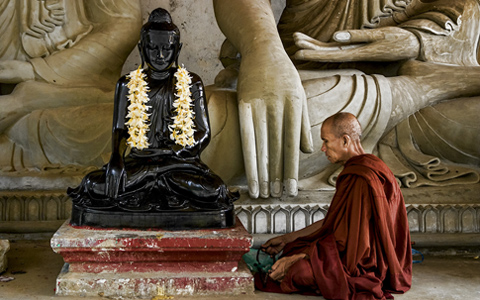 5 days Tibetan Hermitage and Yamdrok Lake Meditation Tour
5 days Tibetan Hermitage and Yamdrok Lake Meditation TourLhasa-Pabonka-Pabogka Rizhui-Dray Yerpa-Yamdrok Lake
-
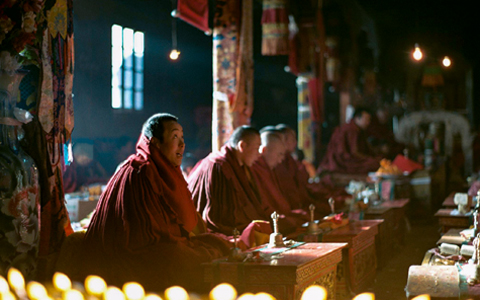 7 Days Lhasa, Samye Monastery and Chim-puk Hermitage Meditation Tour
7 Days Lhasa, Samye Monastery and Chim-puk Hermitage Meditation TourLhasa-Pabonka-Pabongka Rizhui-Drak Yerpa-Samye Monastery-Chim puk Hermitage
-
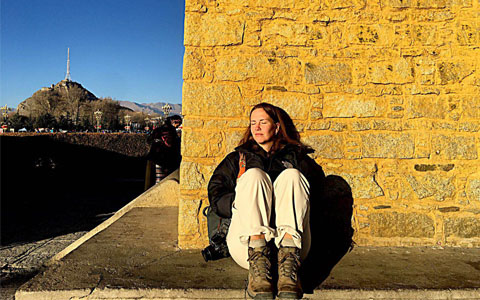 9 Days Lhasa to EBC Meditation Journey
9 Days Lhasa to EBC Meditation JourneyLhasa-Gyantse-Shigatse-Everest Base Camp-Shigatse-Lhasa
Most Frequently Asked Questions from our Clients

If you are looking for the ultimate in meditation locations in Tibet, then this is the ideal route to take across the vast Tibetan plateau. Few people get to meditate in the sacred monasteries and holy sites of Tibet, and this unique opportunity is the chance of a lifetime to be as one with the universe in the company of the world’s most devout monks.
Tibetan Travel Guru,Kham Sang
Get A Quotation of this Tour
Get Started - 14 Days Ultimate Holy Mt.Kailash and Manasarovar Meditation Tour
You’re getting closer to your dream Tibet vacation! Fill out this form so our travel designers can start helping you plan a trip.
Privacy Policy: Your information is kept strictly confidential. Tibet Vista will never sell, trade, or give away your contact information to a third party.

.jpg)



